Physalis spp.
Ever wish you could plant a berry bush or fruit tree and get instant fruit? Ground cherries are the answer to your impatience!
Related to the ubiquitous garden tomato, these summer annuals can be included in your veggie garden to provide a crop of delicious, tropical-flavored fruit in just one growing season.
Ground cherries are known by a seemingly endless list of common names, including Cape gooseberry, poha berry, pichuberry, ground tomato, strawberry tomato, golden berry, Inca berry… and the list goes on!
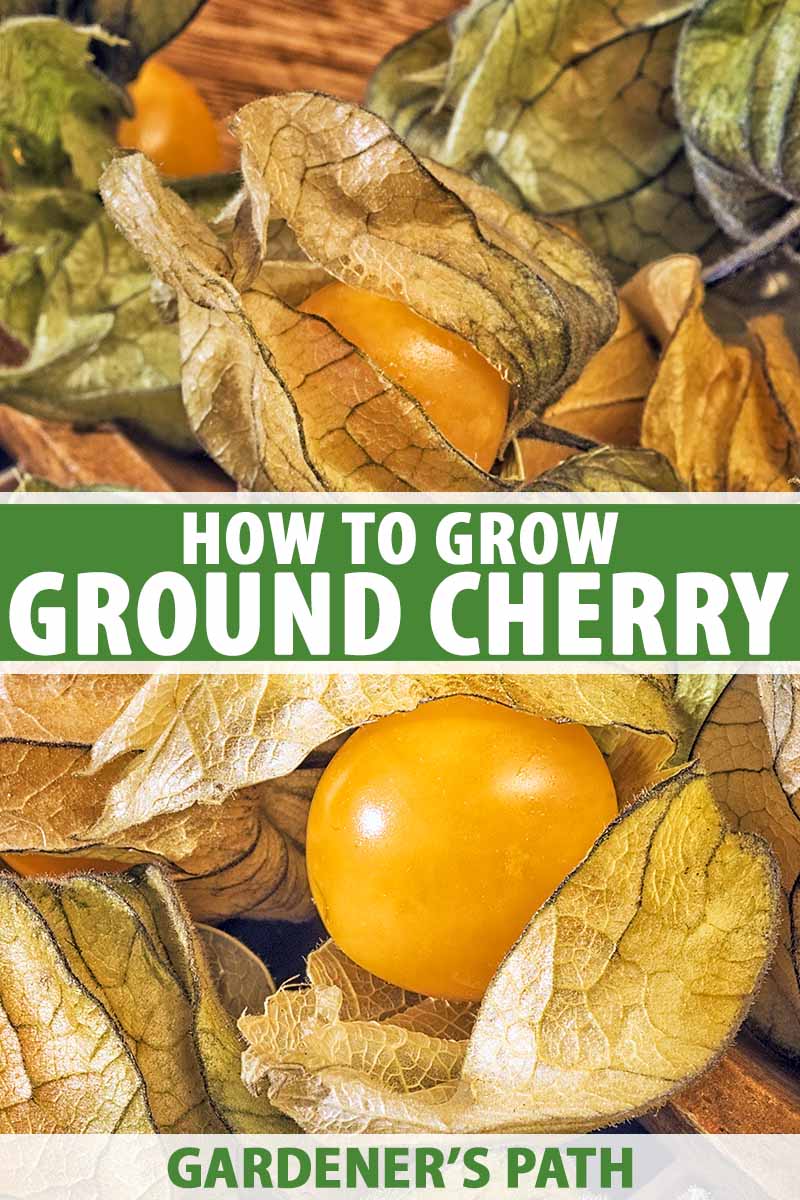
We link to vendors to help you find relevant products. If you buy from one of our links, we may earn a commission.
Whatever you call them, these little berries are a superfood that you can easily grow for yourself.
Let’s dig in:
What You’ll Learn
What Are Ground Cherries?
Here’s a member of the nightshade family that will inspire your sweet tooth.
If the leaves and flowers look familiar, that’s because these plants are related to eggplants and tomatoes. In fact, they are sometimes referred to as “husk tomatoes.”
The plant can grow low, hugging the ground, or more upright, depending on the variety and growing conditions. They have velvety leaves, purple-veined stems, and tend to sprawl.
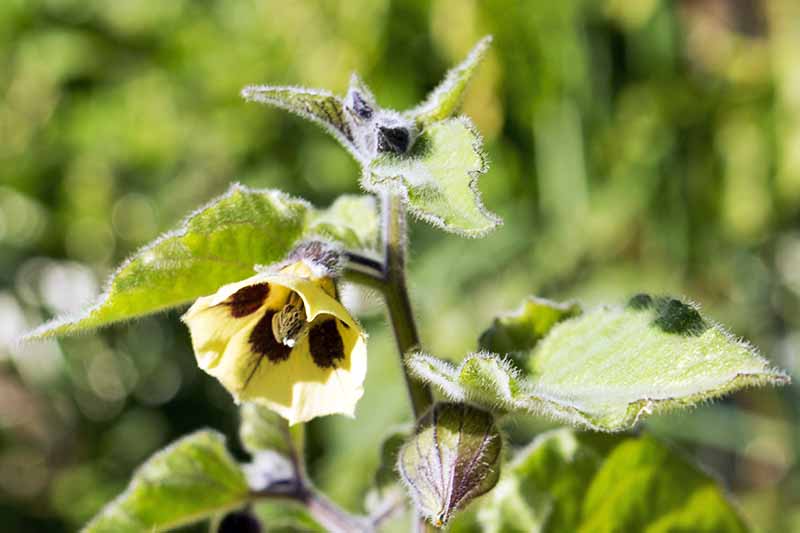
Ground cherry flowers are bell-shaped and white to yellow with purple centers.
Fruits grow inside of lantern-shaped husks that turn from green to tan and take on a papery texture when the berry inside is ripe.
The husks eventually break down, leaving a delicately webbed encasement around the berry.
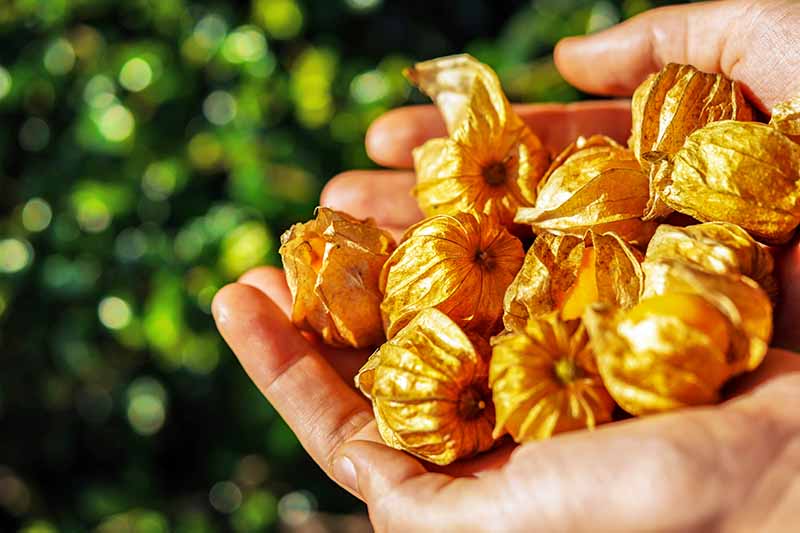
These delicious orange-yellow berries have a tropical taste that some describe as pineapple with a hint of vanilla, and others describe as strawberry with tomato undertones.
It’s their pronounced tart flavor that everyone will agree on.
Cultivation and History
The term “ground cherry” refers to several species of Physalis plants. While there are at least 75 species of Physalis, not all of them have edible fruit.

One of the most distinctive members of this genus is Chinese lantern (P. alkekengi), a unique plant that is grown as an ornamental rather than for its berries.
Edible ground cherries may not have the showy color of Chinese lantern, but their husks enclose a foodie’s delight. While this fruit may be trending as a superfood, it has been cultivated since the 17th century, according to Karen Hager at the Roanoke Times.
One of the most common types, P. pruinosa, is native to warm, subtropical Central America like its relatives, tomatoes and tomatillos.
Another species native to Peru and Chile, P. peruviana, is commonly called Cape gooseberry or golden berry.
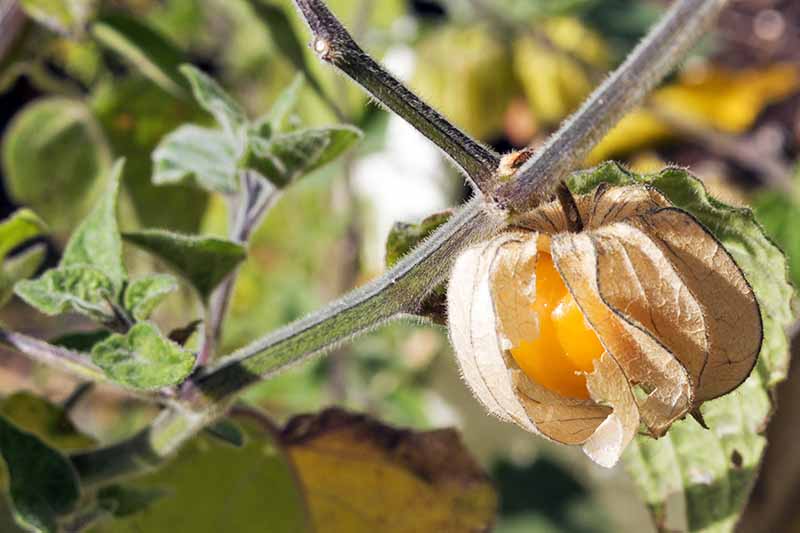
Many species of ground cherry have naturalized in North America, but the most common place that many of us will find ground cherries is in heirloom seed catalogs, rather than in our own backyards.
Propagation of Ground Cherries
Speaking of seed catalogs, are you ready to try growing your own ground cherries?
You can plant transplants directly into your prepared garden soil, start seeds indoors, or even try direct sowing.
From Seed
Most seed companies recommend starting the seeds indoors rather than direct sowing. But the ease with which these seeds grow as volunteers is proof that direct sowing is certainly an option.
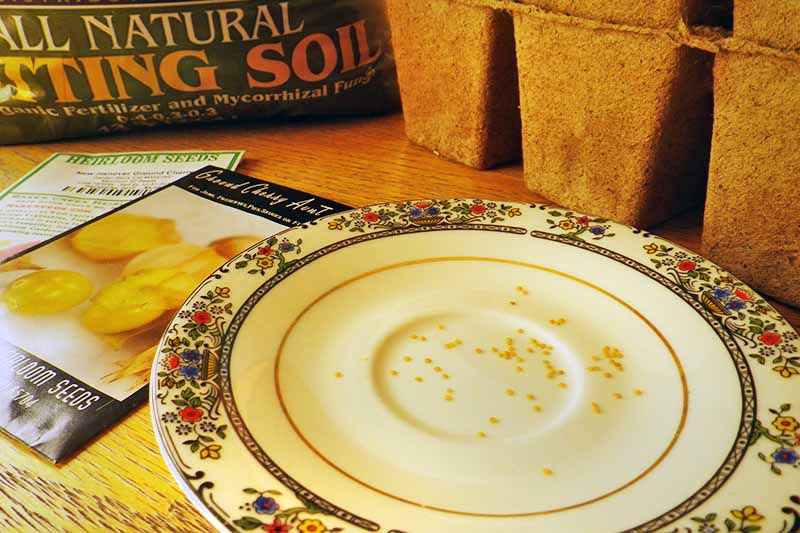
If you do choose to direct sow, plant seeds after your last frost. Loosen the soil and work in some compost. Moisten the soil then pat it down gently without compressing it.
Place your seeds on top of the soil and then cover lightly with a thin layer of soil, about a quarter of an inch. Pat soil gently.
Water after planting seeds, and then daily with a gentle spray from your watering wand until the seeds are established.
Seeds should germinate in approximately five to eight days.
Ground cherry seeds have a low germination rate, so plant more than you need. When seedlings are well established, thin them so plants have at least two square feet to spread.
From Seedlings or Transplanting
Start seeds indoors six to eight weeks before your last frost. You’ll find all you need to know about starting seeds indoors in our guide.
If you want to skip the seed starting business altogether, you can obtain transplants from heirloom seed companies such as Seed Savers Exchange. Or ask your local nursery!
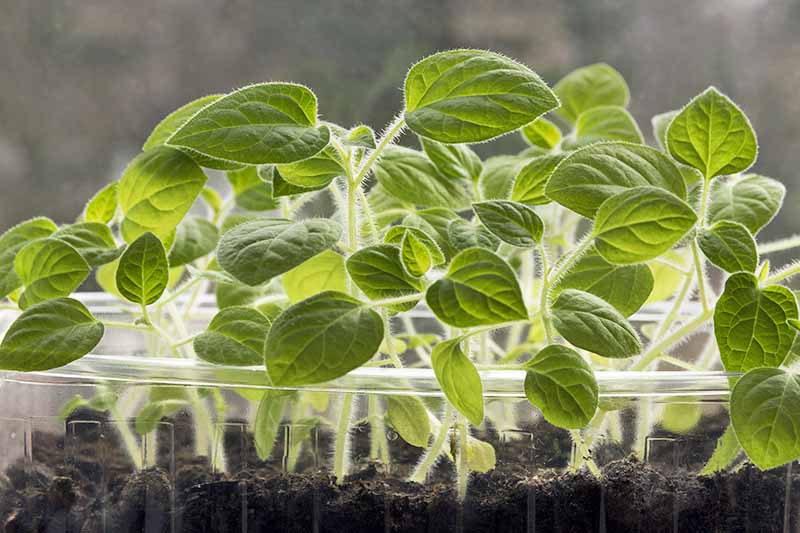
When planting seedlings or transplants, wait until two to four weeks after your last average frost. Harden off before transplanting into a sunny location with well-drained soil.
Ground cherries are notorious self-seeders, so plant once and you may never need to plant them again!
How to Grow Ground Cherries
Plant seedlings or transplants in well-drained soil amended with compost. Don’t over water – they don’t like to keep their feet wet.
If you have heavy clay soil, you may want to plant them in a raised bed. In my drylands garden, they do great in a sunken row.
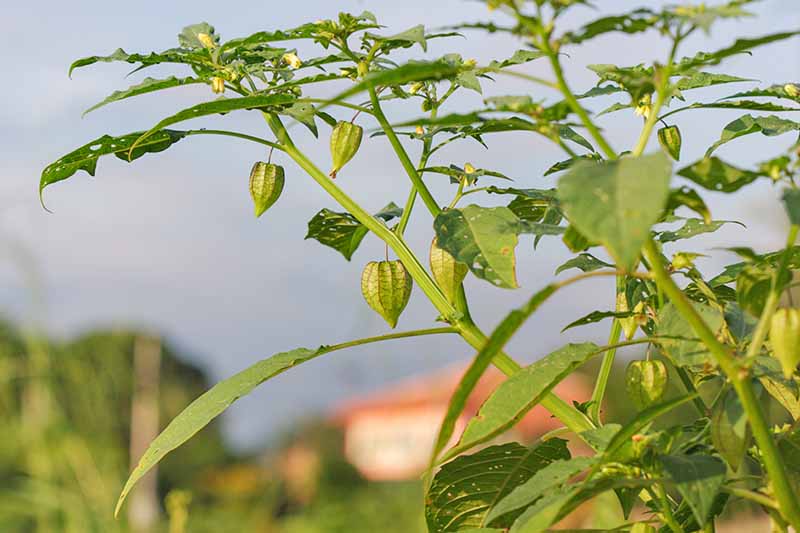
If planting in containers, make sure the roots have plenty of room. Each plant should be in a gallon-sized pot or larger.
Whether growing them in the garden or in containers, make sure you give them room to sprawl – a single plant can take up two to three square feet.
They generally do not need to be staked, though some gardeners do stake leggier plants.
Growing Tips
- Mulch beneath the plants with straw for easier harvesting and to conserve water.
- The plants will produce more fruit in full sun but can tolerate light shade.
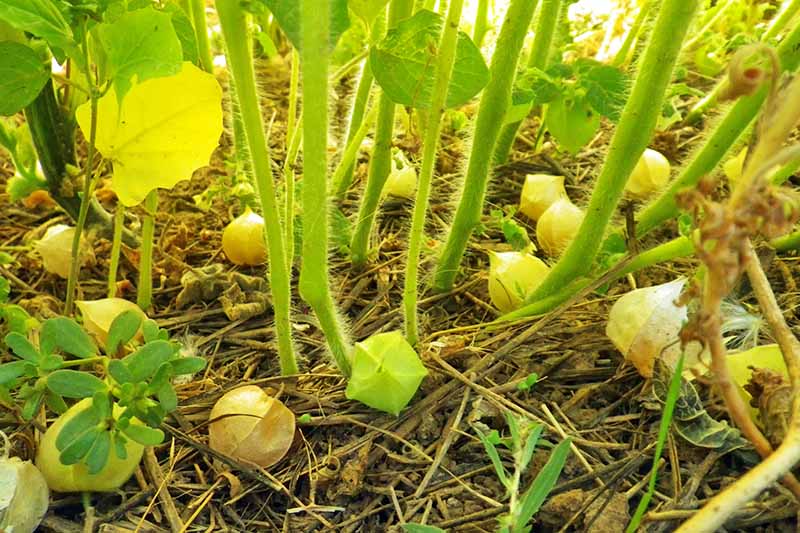
- Cover with a row cover if there’s a risk of frost, and to extend your growing season.
- As always, when you plan your garden next year, make sure to rotate your nightshades to prevent nutrient depletion and the spread of disease.
Cultivars to Select
Wherever you live you will probably find a cultivar or species of ground cherry that will work for your climate.
P. pruinosa grows best in USDA Hardiness Zones 4 to 8, while P. peruviana can be considered a perennial in Zones 10 to 12.
And there are many other edible species, including the “clammy” type (P. heterophylla, aka Rowell’s ground cherry), which is native to the US and hardy in Zones 7 to 10.
Another US native, “common ground cherry” (P. longifolia) was used by Native Americans for food.

A garden full of a variety of different species would be a beautiful thing! But most likely, you’ll want to start with the basics.
The most commonly available seeds are cultivars of P. pruinosa.
Aunt Molly’s
‘Aunt Molly’s’ is the classic ground cherry, the most widespread cultivar of P. pruinosa and the most common variety to buy as a transplant.
The fruit is sweet, tart, and tropical.
Ground Cherry
This open-pollinated variety of P. peruviana produces one-inch, golden fruits with a sweet, slightly tart flavor.
Seeds are available at Eden Brothers.
Mary’s Niagara
This variety of P. pruinosa is very low growing with a wider, three- to four-foot spread.
The fruits ripen earlier than other varieties, so it is good for climates with short growing seasons. It is said to have a subtle sweet flavor.
New Hanover
Some think this is better tasting than the ‘Aunt Molly’s’ cultivar. This is another sweet and fruity variety of P. pruinosa.
Pineapple
Also known as ‘Cossack Pineapple,’ this P. pruinosa cultivar produces fruit that tastes like – you guessed it – pineapple! The berries are fruity and sweet.
Seeds are available from Eden Brothers Nursery.
No matter where you live in the US or which cultivar you pick, you should be able to harvest fruit in one season.
Managing Pests and Disease
If you’re a laid back type of gardener, then ground cherries should be part of your repertoire.
These plants are not particularly prone to bacteria, fungi, or viruses. Although they are rarely targeted by garden critters, occasionally you may find your plants visited by some unwelcome guests.
Herbivores
Ground cherries may attract the same types of animals as your other tasty garden goodies – squirrels, raccoons, rabbits, possums, and deer. Luckily the ripe fruit are fairly well-hidden, so most four-legged garden intruders will not find them easily.
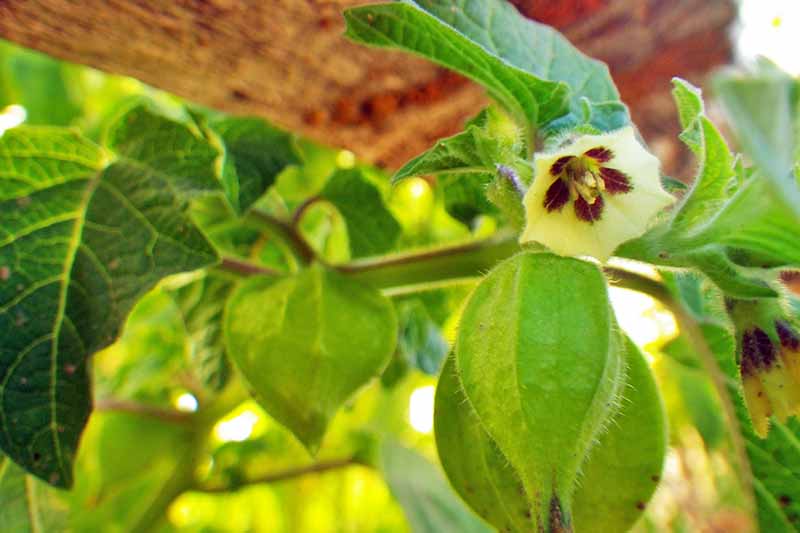
Fencing will certainly help keep the bigger critters out, and floating row covers will offer even more protection.
Insects
While ground cherries aren’t particularly prone to insect problems, there are a few bugs that might find your plants as delicious as you find the fruit!
Cutworms
Cutworms can be a problem for young seedlings. Protect seedlings with plant collars or by sprinkling eggshells or coffee grounds around the base of young plants.
Be sure to correctly identify these guys, as they look similar to some beneficial butterflies.
Read our complete guide to cutworm control for more tips.
Tomato Hornworms
Tomato hornworms will munch on any nightshade plant, so ground cherries are definitely on the menu.
Inspect your ground cherry plants (and other nightshades) for these big, juicy caterpillars and remove them. They make excellent treats for your chickens, or can be squashed under your heel.
Learn more about combating tomato hornworms here.
Colorado Potato Beetles and Ground Cherry Leaf Beetles
These beetles are easy to spot – although they are on the small side, they look like little clowns with their bright yellow and black stripes.
If you find any on your plants, pick them off and squish them.
Find tips on colorado potato beetle control here.
Flea Beetles
Flea beetles are tiny beetles that will chew holes in the leaves of your ground cherry plants. In healthy plants, this will probably only be an aesthetic concern. Plant basil nearby to repel these pests.
Read our guide on flea beetle control for more tips.
Your main strategy for keeping your ground cherry plants insect-free should be inspecting your plants regularly.
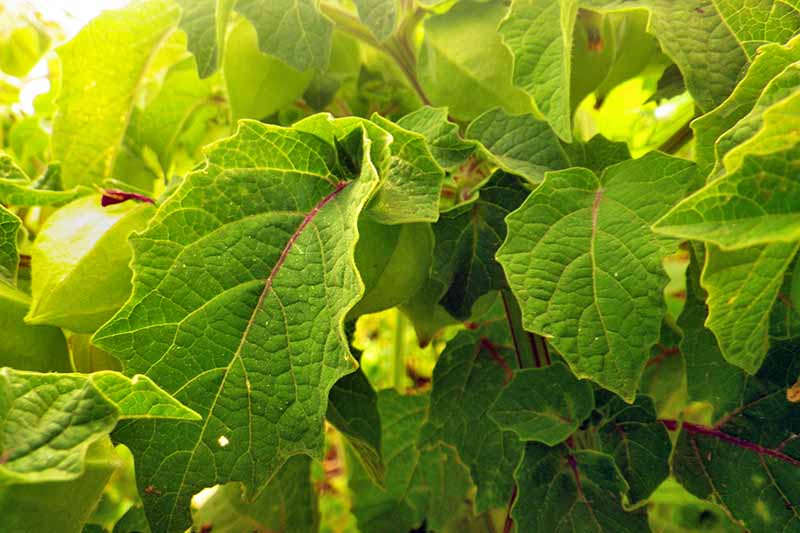
And since nightshade-loving pests tend to eat any member of this plant family, keeping your tomatoes, eggplants, peppers, potatoes, and ground cherries separated with non-nightshades will keep those pests from smooth sailing on the free food expressway!
Harvesting Ground Cherries
Ground cherries have so many things going for them – they are tasty, easy to grow, and even easy to harvest.
How do you know when it’s time to harvest them? When the berry ripens, it falls to the ground in its protective husk – thus the name!
The berries will ripen gradually after the plants reach maturity, usually starting in July or August and up until your first frost.
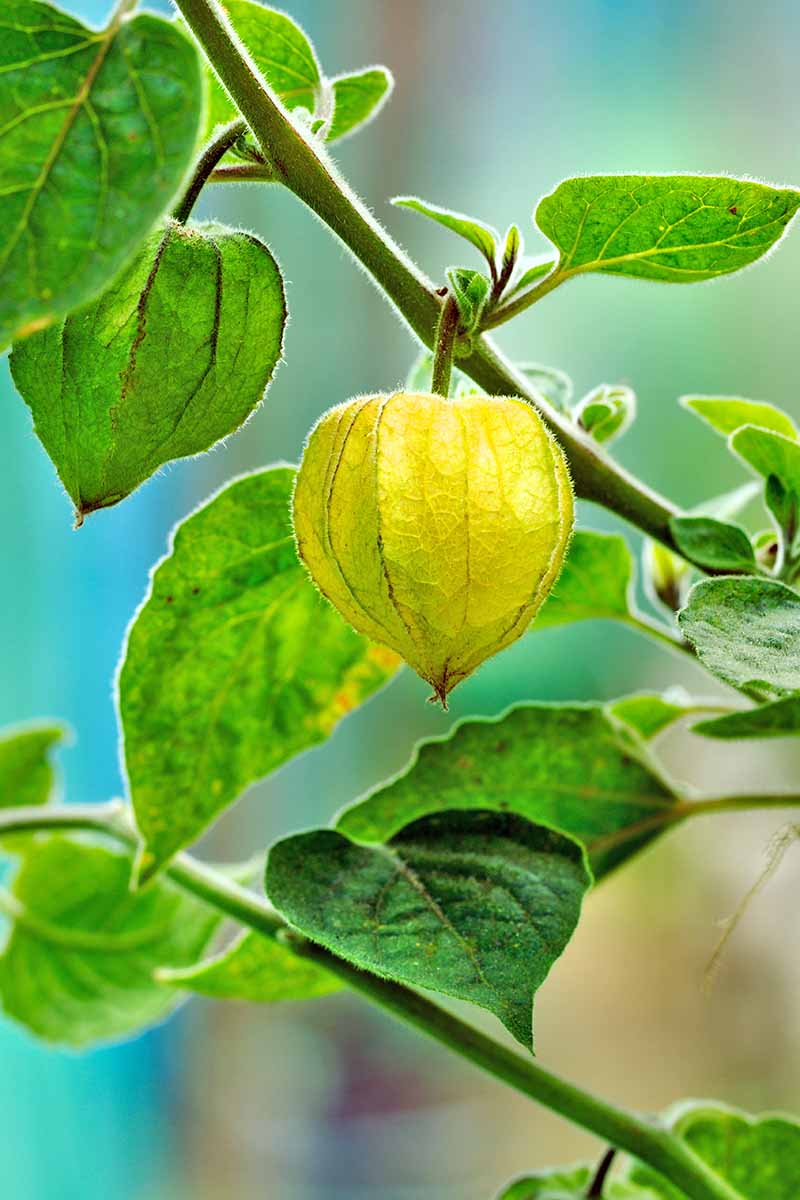
On ripe fruit, husks will be straw-colored and papery while the fruit inside will be somewhere in the yellow to orange range. Leave green-husked fruit on the plant to ripen.
Once you start noticing ripe fruit, look underneath the plant every day or so to collect any fallen berries. Mulching under your plants will make harvesting easier.
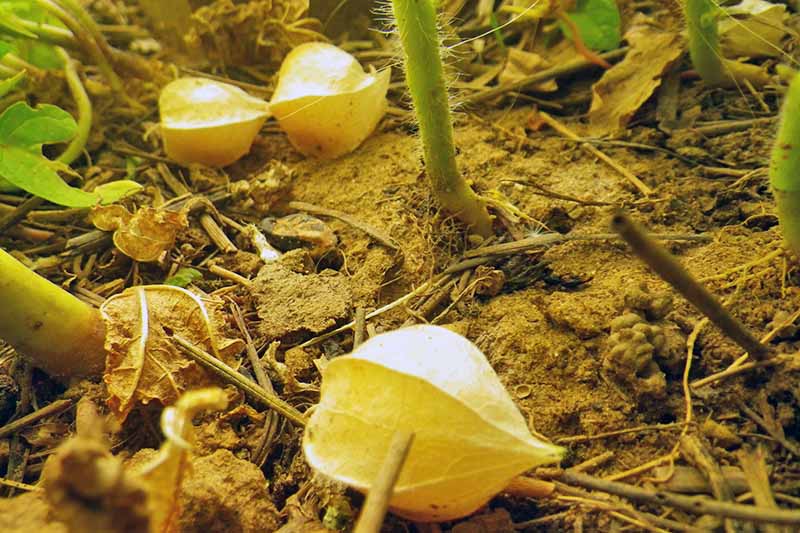
Use floating row covers to extend your growing season, but when it’s time to put the garden to bed for winter, you can harvest unripe berries in their husks.
Store unripe fruit at room temperature in a single layer to ripen. Smaller fruit may not ripen fully – only eat those that are ripe, as the leaves, stems, husks, and unripe fruit may be toxic.

As for ripe fruit, they will keep longer in a cool environment, such as a fridge, basement, or root cellar. For longer storage, just make sure to keep them unwashed and in their husks.
Ripe ground cherries can be stored for three months in the right conditions.
Preserving
Another thing to love about these members of your garden is that a single plant can produce hundreds of berries.
These berries are a great source of antioxidants like vitamins A and C, as well as various B-complex vitamins. Consider preserving your harvest if you grow a bumper crop.
Before preserving, remove husks, and rinse berries. You can preserve them by making jam, dehydrating, freezing, or fermenting.
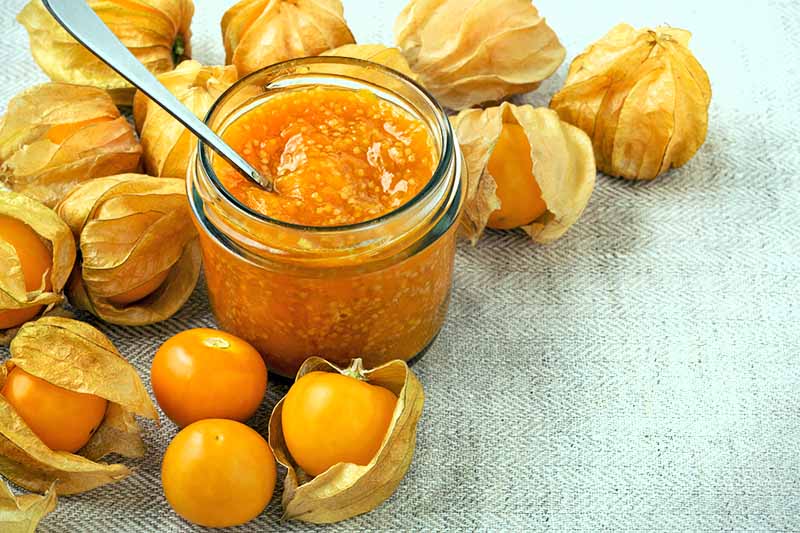
Leave fruits whole or cut them in half for jam. Jam made with ground cherries will brighten up your winter and make exciting gifts for your foodie friends.
Find tips for making your own jams and jellies on our sister site, Foodal.
You can dehydrate ground cherries in much the same way as you would dehydrate grapes to make raisins.
Dehydrating concentrates flavors, so you can use your dehydrated harvest to flavor muffins or cookies, add them to trail mix for a burst of tartness, or sprinkle them on top of your oatmeal. Read more about dehydrating the garden’s bounty here.
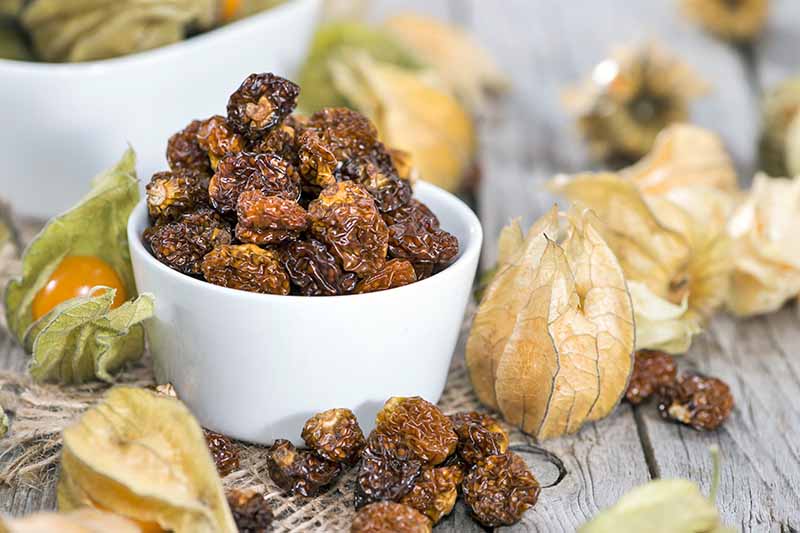
The fruit can also be frozen for later use.
Place clean fruit on a baking sheet, then place the baking sheet in the freezer. Freeze for half an hour or so, then remove the baking sheet and put the flash-frozen ground cherries in a glass container with a lid. Store the container in the freezer.
Read more about the ins and outs of freezing garden produce now on Foodal.
Cooking Ideas
If you don’t eat them all in the garden, cooking the berries is a delicious way to transform them.
Cook them down into a sauce to drizzle over vanilla ice cream or plain yogurt. Or chop them up with some hot peppers, onions, and cilantro and turn them into a peppy salsa!

When I lived in Paris, I would often see a single ground cherry placed as a garnish on top of a dessert with its papery husks folded back like wings. So pretty!
Quick Reference Growing Guide
| Plant Type: | Annual/Perennial fruiting herbaceous plant | Water Needs: | 2 inches per week |
| Native to: | Central America | Maintenance: | Low |
| Hardiness (USDA Zone): | 4 and up, varies according to species | Soil Type: | Organically rich |
| Season: | Summer | Soil pH: | 6.0-6.8 |
| Exposure: | Full sun to light shade | Soil Drainage: | Well-draining |
| Time to Maturity: | About 70 days | Companion Planting: | Basil, cleome, cosmos, parsley, Queen Anne’s lace, Aster family flowers |
| Spacing: | 2-3 feet | Avoid Planting With: | Other nightshades |
| Planting Depth: | 1/4 inch (seeds) | Family: | Solanaceae |
| Height: | 12-24 inches | Subfamily: | Solanoideae |
| Spread: | 24-36 inches | Genus: | Physalis |
| Tolerance: | Poor soil | Species: | Alkekengi, heterophylla, longifolia, peruviana, pruinosa |
| Common Pests: | Hornworms, Colorado potato beetles, ground cherry leaf beetles, cutworms, flea beetles | Common Disease: | Alternaria leaf blight and stem cankers, anthracnose, blight, fusarium wilt, mosaic virus |
A Taste of the Tropics, Fresh from Your Garden
Ground cherries will add an exciting new flavor to your veggie garden, and when you pop open that jar of ground cherry jam mid-winter, its tartness will contrast beautifully with the winter weather.

Do ground cherries brighten up your life as much as they do mine? If so, tell me about it in the comments.
If you want to learn more about nightshades or growing rare fruit, here are a few more guides you’re bound to need:


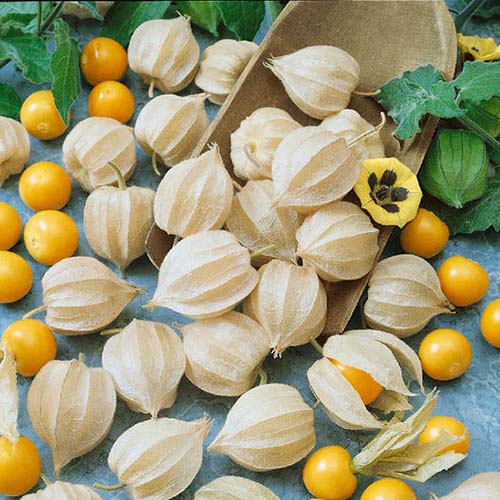
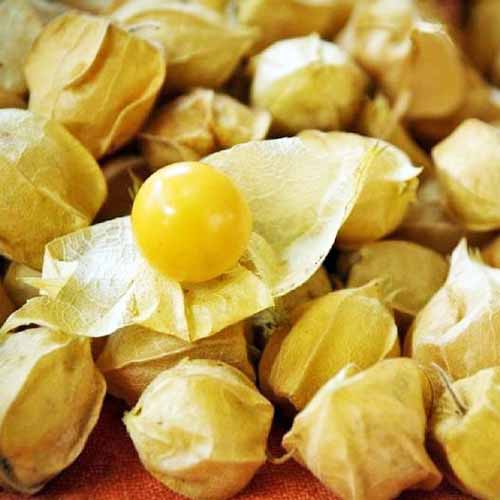
Wonderful and very helpful article. I’m about to plant my ground cherry in a container and you article was very informative. Thanks.
Hi Miguel! Thanks so much for taking the time to let us know you liked the article! Enjoy those ground cherries!
Trying my hand at growing ground cherries in a container on my deck and I’ve noticed that a number of the berries are still green but they’re outside of the paper (still green also) husk. Am I doing something wrong?
any tips are appreciated – thank you!
Hi Aminah, Thanks for your question! So, I don’t remember ever having this problem with my own ground cherries but I did a little research and found that ground cherry husks can open prematurely due to environmental conditions, like heavy winds. I would just leave them on the plants and wait. I bet they’ll ripen up eventually. If they happen to fall off the plants when the berries are still green, collect them and place them indoors somewhere dry. When I collect green ground cherries in the fall, most of them eventually ripen indoors. Good… Read more »
Thank you for this information. Mine, also, don’t get yellow, but stayed green. I will try to see.how they do if I bring them in the house.
I am working on slowing replacing plants in my garden with edibles.I started with strawberries on the tree lawn. Now I have ground cherries as a hedge next to.the house.
Hi Jen,
You’re very welcome. I love your approach to converting to edibles. As for your ground cherries staying green, I think your growing season may not be quite long enough for them to ripen. If you take them indoors, just be aware that they are going to need sunroom-like conditions with several hours of direct sunlight. Another option is to leave them outdoors but use cover cloths to protect them from light frosts. You might want to have a look at our article on extending the harvest season for ideas.
Happy gardening!
Physalis pruinosa is native to Central America and adjacent regions, not the Mediterranean or East Asia. Same goes for most of that genus, including other species of ground cherry. I’m sure they’ve naturalized in those areas — they’re certainly grown throughout Europe — but they weren’t introduced until the Columbian exchange.
Hi JFM,
Yes, there is definitely an error in the quick reference growing guide that you are right to point out! If you noticed in the body of my article I talked about where they are native to – Central America. I will make sure we get the origin in the quick reference growing guide updated asap. Thanks for letting us know about this slip up!
Good information; thank you. I am growing the pineapple variety this year and it is my first year growing any ground cherry. I snack on them as I go through the garden. Hopefully I will save enough to make a couple of jars of jam (I have 3 plants). So fun to grow!
Hi Michele! Thanks for taking the time to comment and tell us about your own patch of ground cherries. Aren’t they delicious? And the jam is simply divine. I hope your harvest ends up being generous enough for a couple of jars! Happy garden snacking! ????
CAN I GROW PINEAPPLE CHERRIES IN A TROPICAL CLIMATE?
Hi Noemie,
Yes, you can grow pineapple ground cherries in a tropical climate.
They have naturalized in Hawaii where they are called “poha.”
Since you won’t get any killing winter frosts, the plants should keep growing as long as they are kept free from disease and pests!
You may want to give each plant a bit more space than I recommended in the article – I’ve read that in tropical climates these may grow to 4 feet tall with a 7 foot spread.
Hope this helps!
yes they will actually grow more easily
I had a wonderful experience with husk cherries the first time around. We live in Charleston, SC and no one I know grows them here so we were truly delighted with the abundant, delicious and beautiful crop. In the end we were seeing hook worms or tomato worms in ours so we just stopped picking. Now I am sorry I didn’t do more to deter the pests. I understand these plants are perennials, will they die back? May I plant a winter crop where these are planted? I have them in a raised bed so I would like to plant… Read more »
Hello Jacqueline from Charleston! I’m a big fan of your lovely town and have spent many fond moments there. Such a beautiful place! Isn’t it funny how under the radar these fruits are as a garden plant? They are so tasty! These plants are considered annuals for most of us – my info on ground cherries tells me that they are perennial only in zones 10-12. It looks like you are in zone 9a, so you’re close but if you have freezing temperatures during the winter, the plants will be killed and then they won’t come back. They are like… Read more »
Can I find/plant ground cherries now or do I need to wait until spring?
Hi Colleen,
You can find seeds now, but as far as planting them, that depends where you live!
If sowing from seed directly into your garden ground cherries would probably take at least 100 days to reach maturity. Unless you live in one of the very warm, southern areas of the US (or a similar climate), I would wait until next spring!
Hope that helps!
Hey Kristina I really enjoyed your article on ground cherries. I have been growing them for several years now in my backyard raised beds and in pots! I use them for snacking raw and for jam making, which turns out great. Have also blended with my red raspberry for a unique flavor. I give out as gifts to a lucky few and sell some with my other jams (grape, red raspberry, and ground cherry).
By the way forgot to mention my area is Green Point Brooklyn, N.Y.
Hi Benjamin! Thanks so much for taking the time to leave a comment! I’m glad you enjoyed the article!! Ground cherries make such amazing jam. I am drooling at the idea of a raspberry-ground cherry jam. I haven’t tried that – it sounds incredible. Have you had any problems with your ground cherry crop? The only issue I’ve had with mine is tomato hornworms – but only one year so far, and they were feasting on every nightshade they could find. They were easy to pick off and the ground cherries rebounded. I find this crop incredibly easygoing. Feel free… Read more »
I have two pineapple cherry plants growing huge with lots of cherries not ripe yet. Some of the leaves are drooping/curling downward. One leaf has turned yellow. What is the drooping and yellow a sign of? Loved your article. Very helpful.
Hi Richard, I’m so glad you found the article helpful! I’m sorry to hear your plants are looking less than stellar. Are you experiencing any cold temperatures yet in your area? Once temperatures get cold, and the first frosts come, these plants eventually die back. I’m in zone 5b and mine are gone now. Next step – have you inspected them for pests? Pests can sometimes cause such symptoms, and can also spread disease. Make sure to look under the leaves as well. If neither of those seem to be the issue, I’m going to suggest you have a look… Read more »
And when I say drooping, it’s kind of in a stiff way. Not limp but kind of stiffly pointing downward.
Would you be able to share a photo here? That would help!